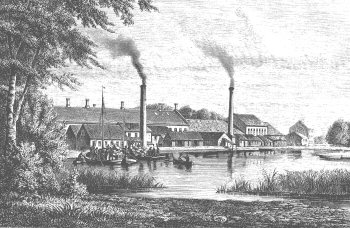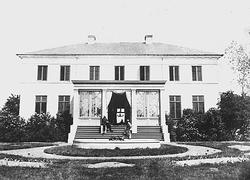| The Silkeborg Paper Mill | ||||||
|
Du er her: Forsiden |
||||||
|
The Silkeborg Paper Mill. A brief overview
By Annie Mortensen
Once upon a time - about 155 years ago - a fairytale took its beginning right in the middle of Denmark in what was to become one of the most beautiful cities in Denmark - Silkeborg. As you may know the Chinese invented not only the powder but also the paper which was produced from rags almost 2000 years ago. It took, however, quite a while before Europe gained the knowledge behind this invention. Paper was not used in Denmark until the 14th century and a couple of hundred years or so later a small production started in Denmark. At the beginning of the 18th century the production expanded with a paper machine in a paper mill north of Copenhagen. Paper mill founded 1844 In 1844 the owners of that mill got permission to establish a new PAPER MILL near the river Gudenå. At that point Silkeborg basically consisted of a couple of small houses, a large farm and 30 inhabitants. Also, the state wanted to establish a market place in the dark Jutland which they called the region because of the impassable character and lack of civilization. That was changed with the paper mill and the market place - within a few years Silkeborg grew into a town as the new factory attracted people from the entire country. The river Gudenå delivered the large amounts of water The river Gudenå was the main reason why anybody would want to build a factory in the wilderness. The water was used to run a wheel which served as source of energy for the machines in the mill. Furthermore, the river Gudenå served as a means of transportation for raw material as well as for the manufactured goods. The river also delivered the large amounts of water necessary for the production of paper in a mixture with rags. The construction of the mill was a gigantic industrial project compared to the existing standards of that time. The mill was equipped with modern machinery and became the largest paper mill in Denmark and centre for the production of machine-made paper. At its peak the mill had more than 2,000 employees and a yearly production of 70,000 tons of paper. The huge area - 220,000 square metres - presented a number of interesting buildings reflecting the history of the Danish industrialism. Danish bank notes were made in Silkeborg One of the buildings has a special history as it was here the Danish National Bank produced the fine handmade and watermarked paper for the Danish bank notes from 1910 till 1956. This production was of course surrounded by certain security precautions and it was a very special and honourable task handed over to the paper mill in Silkeborg. Michael Drewsen and the paddle steamer "Hjejlen" The pioneer behind the paper mill in Silkeborg was Michael Drewsen. He settled down in Silkeborg where he got to play an important role in town. He was full of enterprise and took a number of initiatives. He was the main initiator behind The Hjejlen, the oldest still functioning paddle steamer of the world - to day still one of Silkeborgs greatest tourist attractions, he brought the railway and the telegraph to Silkeborg and also served in the Danish Parliament where he was a warm spokesman for the introduction of the Danish constitution in 1849.
He also found time to invite many guests into his private home, among these Hans Christian Andersen, our Danish writer famous for his fairy tales, who visited him several times and would entertain the dinner guests with his fairy tales. Another friend was the Danish King Frederic the 7th. Michael Drewsen sold the paper mill in 1870 but time was hard for the paper business and in 1889 the paper mill in Silkeborg and most other Danish paper mills were united. In the following years the Danish paper industry faced several crises as foreign competition increased and the mill in Silkeborg was no exception. After several changes of ownership the factory closed down at the end of the 20th century - but the history continues. The machines stopped in the year 2000 Already before the last machines stopped in the year 2000 the area was bought by investors and steps were taken to initiate the revival of this old part of the town and make it a new and vivid neighbourhood. New times: The area integrated as a central part of the town As a result of a cooperation between the investors, the municipality of Silkeborg, and an architect company a strategy was made for the area. The strategy was that the area should be opened and integrated as a central part of the town. Some buildings had to be pulled down and others to be rebuild for different purposes. Trees were cut down and bridges build across the river Gudenå to open the area and make it visible and accessible. The first building to reopen by the riverside houses a SAS Radisson hotel, the local newspaper, Midtjyllands Avis, found new premises in another very special building, an advertising agency's new domicile is centered round one of the old lifting devices - enabling them - as they put it! - to work with heavy solutions! There are rows of cafés, restaurants, the city cinema is here, the biggest fitness centre is here - my dentist is there!, there is a new music and theatre house, Performers' House, art house, companies, apartments - both for rent and to be owned. All these have seen the possibilities in combining history with development and the area has already become a popular attraction. The area has been gently restored - still with an emphasis on the unique industry architecture, yet combined with modern architecture. Paper Museum And in one special building the paper mill lives on: in the Papirmuseet Bikuben [The Paper Museum Beehive] the original production premises for special hand-made paper have been preserved and the visitors can follow the process and even try for themselves to make the paper - although - for security reasons - not the special watermarked kind. An old fairy tale has become a modern one In that way the history of the paper mill in Silkeborg is preserved and an old fairytale has become a modern one. Annie Mortensen Useful links
Published September 29, 2005. Webredaktøren. |
||||||

